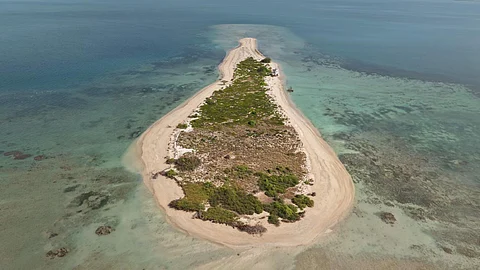

The Tamil Nadu government has started an initiative to save the sinking Kariyachalli island in the Gulf Of Mannar region, one of India’s most ecologically sensitive marine zones. The Tamil Nadu Sustainably Harnessing Ocean Resources (TNSHORE) project, expected to start in August 2025, will try to restore the reefs with artificial modules, planting seagrass beds and reviving marine life.
Kariyachalli is one of the 21 islands in the Gulf of Mannar Marine National Park region, located on the southeastern coast of India between Rameshwaram and Thhothukudi. The gulf is home to one of the four major coral reefs in India.
The uninhabited island has sunk significantly over the past few decades due to rapid erosion, rising sea levels and degradation of the surrounding coral reef and seagrass meadows.
The island’s landmass shrank by over 70 per cent in 2024 compared to 1969, according to a January 2025 report by the Indian Institute of Technology Madras’s (IIT Madras) Department of Ocean Engineering. From its original size of 20.85 hectares, the island shrunk to just under six hectares in 2024.
Currently, the island’s landmass measures approximately 3.14 hectares during high tide and expands to about 4.12 hectares at low tide, said Supriya Sahu, additional chief secretary, Department of Environment, Climate Change and Forests.
About a third of the coral around the island has bleached on average and further degradation and disappearance of coral reefs would make the island more vulnerable to erosion, the report stated. At the current rate of erosion, the island is expected to be submerged by 2036. With just a decade left, government authorities are now racing to save it from disappearing.
It is crucial to protect the island from tsunamis, cyclones and coastal erosion, said Sahu. “Climate change is only worsening the situation as the island disappears fast,” she said.
Authorities will deploy 8,500 multipurpose artificial reef modules under TNSHORE. The artificial reefs have trapezoidal structures composed of ferrocement and steel with perforations to enable nutrient flow. The average height of these structures is 2-3 metres weighing 1.8-3 tonnes each, strategically deployed to reduce wave energy moving towards the island and promote sediment deposition.
“These reef modules have been specially designed with an understanding of ocean currents. They aim to stabilise the shoreline, reduce the intensity of waves striking the island and mitigate erosion,” said Sahu. The designs were developed by scientists from IIT Madras and the Thoothukudi-based Suganthi Devadason Marine Research Institute.
The seagrass beds would help further slow ocean currents and enhance biodiversity around the island, she added. Endangered species such as dugongs (commonly known as seacows) feed on the seagrass. The revival of coral habitats would improve the overall ecological health of the area, Sahu explained.
The government has earmarked Rs 50 crore for the initiative. Restoration efforts would cover approximately three acres of coral planting and four acres of seagrass around the island. These measures are also intended to protect fishery resources.
Sahu added that only native coral species with demonstrated resilience to bleaching would be planted. “This year, the corals in the region have sustained with limited bleaching, unlike the mass bleaching witnessed about two years ago,” she said.
The deployment of artificial reefs is expected to take around 45 days, with completion targeted by September. Sahu said tangible results from the restoration would likely be visible only after a year, provided environmental conditions remained favourable.